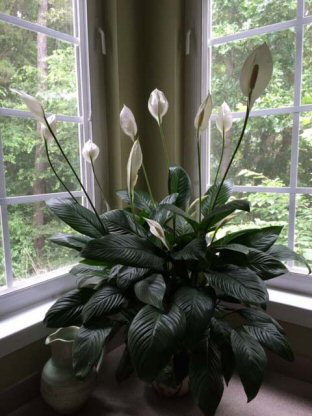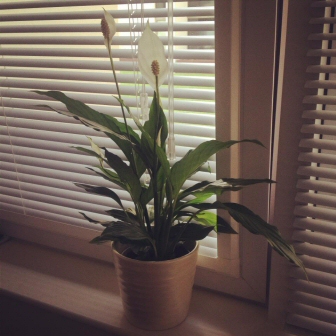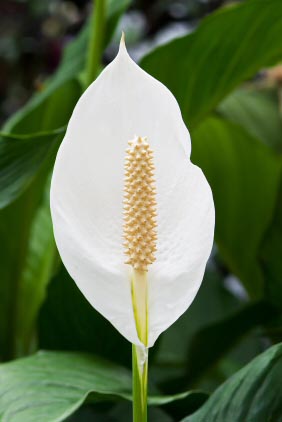





 The Peace Lily Plant or Spathiphyllum first came to Europe in 1824 when it was found by Gustav Wallis in the Colombian jungle. Wallis is remembered for his discovery in the Peace Lily's Latin name of S. Wallis. Along with the lush foliage, it's a cheap plant to buy, simple to care for with easy to follow care instructions and will also help filter the surrounding air of various toxins. When it comes to the meaning of the Peace Lily name this is down to the flowers with the white raised spathe looking like a white flag of surrender.
The Peace Lily Plant or Spathiphyllum first came to Europe in 1824 when it was found by Gustav Wallis in the Colombian jungle. Wallis is remembered for his discovery in the Peace Lily's Latin name of S. Wallis. Along with the lush foliage, it's a cheap plant to buy, simple to care for with easy to follow care instructions and will also help filter the surrounding air of various toxins. When it comes to the meaning of the Peace Lily name this is down to the flowers with the white raised spathe looking like a white flag of surrender.
The Peace Lily has a few all too common questions which this beautiful houseplant seems permanently tied to - "What plants like dark places?" and "Why won't my Peace Lily Bloom again?".
Light Needs
"The Peace Lily plant likes dark places" - This isn't completely wrong, but it's a misleading myth. Many plants will be reasonably happy in darker places but this is ultimately confusing a surviving plant against one that would positively thrive in different conditions.  The Peace Lily is no different, if you put it in a bright spot without direct sunlight, growth will be rapid and robust. Of course as the common stereotype states, it will survive, adapt and grow (albeit slowly) even if you pick a darker spot in your home for it instead. If you are looking to fill such a void then you could do far worse than this plant. It has lush green foliage and a clever trick to let you know when it needs watering, if conditions are favorable you will get tall brilliant white flowers several times a year which seem to float above the plant like mini clouds.
The Peace Lily is no different, if you put it in a bright spot without direct sunlight, growth will be rapid and robust. Of course as the common stereotype states, it will survive, adapt and grow (albeit slowly) even if you pick a darker spot in your home for it instead. If you are looking to fill such a void then you could do far worse than this plant. It has lush green foliage and a clever trick to let you know when it needs watering, if conditions are favorable you will get tall brilliant white flowers several times a year which seem to float above the plant like mini clouds.
Flowers
That first crazy but beautiful flush of flowers you had when you took it out of the store is a result of expert nurseries growing them in a special way
"How do I get my Peace Lily to bloom again?" is the next frequently asked question - A well cared for Spathiphyllum can be expected to produce several flowers a year. When we say several we really do mean several, as in one to three flowers at any one time. More numerous blooms are rare and it's almost impossible to achieve at home no matter how great your care. It's a commonly asked question because most people have brought a Peace Lily from a shop when it's literally surrounded by blooms. They last for several months before eventually going green and then dying off, then when the same number of flowers don't return in the future, people automatically assume they're doing something wrong care wise.
The good news is that if your Peace Lily plant looks healthy, chances are you're treating it exactly as you should. The bad news is that the first crazy but beautiful flush of flowers you had when you took it out of the store is a result of expert nurseries growing them in a special way. Not because they have given perfect light levels, kept the plant slightly pot bound or have watered the plants with rain water (although all three of these things will help at home), but because they have cheated.
Well maybe "cheated" is too harsh, more like, they've done something which normal people at home could never do, they've used gibberellic acid. Gibberellic acid is a plant hormone which Spathiphyllum is somewhat sensitive to , once applied it triggers the plant to produce blooms. Lots and lots of blooms. Plant hormones are like steroids for that muscular but slightly aggressive guy down the gym; they produce fantastic results, but are unnaturally used to create the end result. So if you're worrying about why you can't come close to replicating the results of the nurseries that's the reason why, but you can still get the plant to rebloom, and there is more to a Peace Lily than just the flowers.
, once applied it triggers the plant to produce blooms. Lots and lots of blooms. Plant hormones are like steroids for that muscular but slightly aggressive guy down the gym; they produce fantastic results, but are unnaturally used to create the end result. So if you're worrying about why you can't come close to replicating the results of the nurseries that's the reason why, but you can still get the plant to rebloom, and there is more to a Peace Lily than just the flowers.
Light
As mentioned in the introduction above, darker spots are acceptable for a Peace Lily but don't assume this is what it needs. If given the choice a bright spot avoiding any direct sunlight is much better.
Watering
Try to keep the soil just moist at all times, but if you're quite forgetful you just need to watch the plant for visual hints of when to water. When it's happy it looks like the picture on the right, when it needs water it flops over as shown in the picture on the left. When you water, soak the plant but don't let it "sit" in water. If you're having problems with the plant it's likely to be linked to your watering technique. Check out the problem section further down for hints and clues.

Humidity
If you've very low humidity on a constant basis it will cause you problems in the longer term, so try to increase the humidity in these places. Otherwise the occasional misting is all it needs.
Feeding
Like the water requirements the plant will tell you when you're getting it wrong; too much fertiliser will cause brown spots on the leaves, and too little will result in no flowers and poor growth (assuming the light conditions are bright). To prevent things getting to this stage though, aim to feed with a weak solution once every couple of months in the growing seasons, which will be much appreciated.
Temperature
Average temperatures found in the home all year round are ideal.
Repotting
A slightly pot bound plant is supposed to be helpful for encouraging flowering, but when you decide to repot, try to do it during Spring if possible.
Propagation
When you repot your Peace Lily you can choose to divide the plant. The problem with dividing circular types of plants is you end up with a lopsided result and can ruin the original "bulk". If you do go ahead and divide, face the sparse side towards the light source, it will sprout new growth from that side first, which in time will help balance the plant shape.
Speed of Growth
Moderately in good light conditions. Significantly slower (if at all) if light levels are low.
Height / Spread
This depends on the variety you buy. Although even then, in a indoor home situation they will only expect to reach about 45cm / 18in in height and about that in width.
Flowers
 Of course! There is loads of information on the web about how to get a Peace Lily to rebloom, the problem is that the tips and suggestions don't seem to work for everyone in the same way which is obviously not helpful! If you have a secret to success and you want to share, tell us in the comments section below. Meanwhile here are the best ideas for encouraging reblooms:
Of course! There is loads of information on the web about how to get a Peace Lily to rebloom, the problem is that the tips and suggestions don't seem to work for everyone in the same way which is obviously not helpful! If you have a secret to success and you want to share, tell us in the comments section below. Meanwhile here are the best ideas for encouraging reblooms:
Light - All plants need light for productive photosynthesis, try to find a spot that is light without any direct sunlight. i.e. a North facing window or set deeper into a South facing room.
Rain Water - Many plants respond well to rain water because it has no added chemicals, and contains natural minerals needed by plants. OK, maybe you can't use rain water for every watering, but if you've access to a rainwater collector of some kind, give it a try.
Pot Bound - The rational behind this is that pot bound plants sense they're trapped and can no longer grow, so produce flowers as a means of propagating themselves by seed.
Warmth - A room where you spend a lot of your time will likely be warmer than that spare bedroom, consider sharing your living space with your Peace Lily.
Remember don't expect very numerous blooms like you had when you first brought the plant, and the reasons why this is so are discussed in the introduction above.
Anything else?
The plant is mildly toxic, and especially harmful to cats. It will also need dusting or washing from time to time to keep the leaves glossy and looking their best.
Copyright © www.100flowers.win Botanic Garden All Rights Reserved